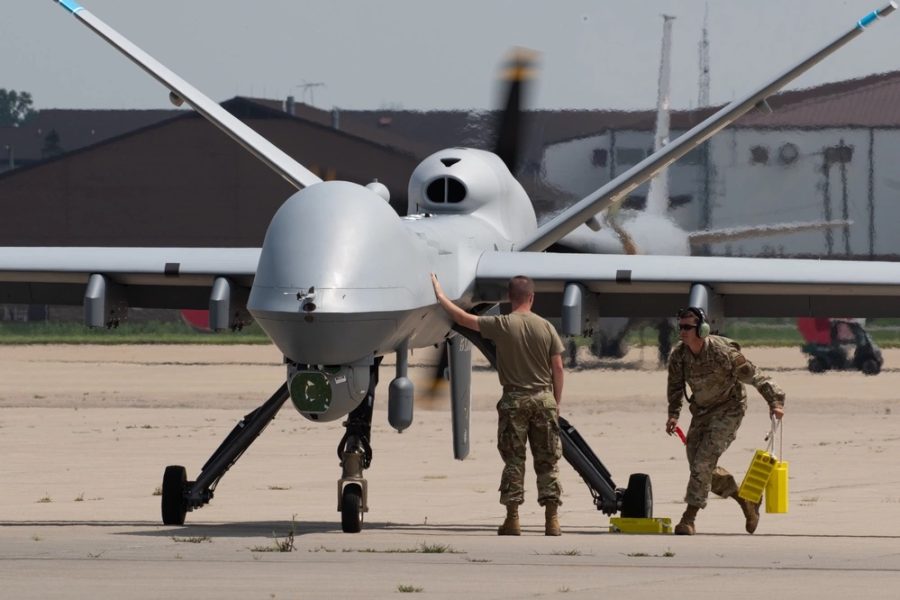Russia threatens ‘WAR’ against US drones helping Ukraine attack targets in Crimea. Is ‘direct confrontation’ next?

In a stark warning, the Russian Defense Ministry announced on June 28 that it had observed a significant increase in U.S. drone activity over the Black Sea and that these flights could trigger a “direct confrontation.”
India and Russia close to a ‘groundbreaking’ joint venture agreement for the S-400 Triumf AD system; a new chapter in the defense alliance?
The ministry’s statement came against the backdrop of rising tensions and the ongoing conflict in Ukraine, where long-range precision weapons supplied by the West, supported by American drones, are increasingly being used against Russian targets.
The US Department of Defense explained the recent increase in US drone operations, accusing them of conducting reconnaissance and targeting missions in support of the Ukrainian military.
“It shows an increased commitment by the United States and other NATO countries to the conflict in Ukraine on the side of the Kyiv regime,” the statement said.

According to the ministry, such actions would have increased the likelihood of incidents involving Russian military aircraft and thus the risk of a direct conflict between NATO and Russia. “NATO members will bear responsibility for this,” it added, underlining the seriousness of the situation.
Russian Defense Minister Andrei Belousov has instructed the General Staff to prepare proposals for an “operational response to provocations,” signaling that Moscow is prepared to take violent measures to deter American reconnaissance flights.
The warning follows allegations from Moscow that the US military helped Ukrainian forces guide long-range missiles for an attack on annexed Crimea on June 23.
Four people were killed in the attack, including a child. Russian officials claimed that the United States provided important intelligence and targeted support for the attack. They threatened retaliation.
However, the Pentagon insists that the Ukrainian armed forces determine their targets independently.
Asked about the Russian Defense Ministry’s warning, Pentagon deputy spokeswoman Sabrina Singh confirmed that American aircraft and drones would continue their operations over international waters.
“We continue to fly, undertake maritime voyages and operate in international waters and international airspace where permitted by law,” Singh said at a briefing.
She noted the reports on the Russian Defense Ministry’s stance on these flights, but declined to comment further.
US drones help Ukraine attack Russia
Since the invasion began, Russia has frequently accused the United States of using drones near its borders to help Ukraine attack targets in Crimea, an issue that has been a point of contention between Washington and Moscow.
In March 2023, a direct clash occurred when a Russian Su-27 fighter jet damaged a US MQ-9 Reaper drone and caused it to crash into the Black Sea. This incident was the first direct encounter between Russian and US forces since the Cold War.

Following the incident, the Pentagon and the U.S. European Command reported that two Russian Su-27 aircraft had dumped fuel on the MQ-9, which was conducting a routine surveillance mission over the Black Sea in international airspace.
The Russian Defense Ministry, however, claimed that the US drone flew close to the Russian border and entered a restricted area.
Large areas near Crimea have been closed to flights by Russia. Moscow has accused US reconnaissance aircraft of flying too close to the borders and ignoring restrictions. This began with the seizure of Crimea in 2014 and continued until the Russian invasion of Ukraine in February 2022.
A repeat of the March 2023 confrontation could escalate tensions in the Ukraine war. During a recent attack by Ukrainian forces on Sevastopol on June 23, a US Global Hawk was spotted near the Russian border.
Shortly afterwards, Russian Telegram channels claimed that an American drone had been shot down over the Black Sea. However, Kremlin spokesman Dmitry Peskov said on June 25 that he had no information about the alleged shooting down.
Although no incidents occurred, the constant presence of American drones near Russia’s borders raises fears of future accidents that could trigger a conflict. American drones play a key role in attacks on Russian military assets.

Writing for the EurAsian Times, Vijainder K Thakur, a former Indian Air Force pilot and defense analyst, pointed out that thousands of US troops stationed in the US and other NATO countries have been actively involved in the conflict. They analyze large amounts of data from US satellites and drones.
Thakur explained that before an attack on Russia, US air and space-based ISR (Intelligence, Surveillance and Reconnaissance) units conduct intensive surveillance of Crimea to select targets and identify air defense systems.
Ukrainian fixed-wing drones are entering airspace over Crimea to activate Russian air defense systems, while US RC-135 Elint aircraft and RQ-4 and MQ-9 drones are recording and analyzing radar signals.
Russian warplanes are “aggressively hunting” US drones near Crimea; Moscow questions direct US involvement in Ukraine war
Through this intensive surveillance, the US discovers gaps in Russian defenses due to technical problems or regrouping, which Ukraine then exploits with long-range weapons supplied from the West.
Russia’s S-500 radar and US Global Hawk drones “destroyed” in information war: Bloggers continue to make wild claims
US drones over the Black Sea
Russia is developing countermeasures in response to ongoing US drone flights over international waters and airspace, which it perceives as a significant threat.
While the exact nature of these measures is still unclear, Russian experts believe that fighter jets and air defense systems could be used.
Igor Malikov, a decorated test pilot, told Izvestia that an immediate response would include the immediate deployment of fighter jets and the activation of air defense systems if a drone was detected.
“To influence a drone without weapons, you have to fly alongside it and cause an impact, for example with a tail stream. But that is dangerous… If you have weapons, what is the point of such maneuvers?” said Malikov.
He explained that the drones will carry out reconnaissance tasks and target missiles aimed at Russian positions.

Valery Gorbenko, former commander of the 4th Army of the Air Force and Air Defense and Hero of Russia, echoed Malikov’s views, advocating closing airspace over neutral waters in response to hostilities, similar to American practices in such scenarios.
“If someone suddenly appears, you have to shoot them down,” Gorbenko stressed, pointing out that small drones can be shot down by maneuvers such as flying over them and dumping kerosene.
However, Dmitry Kornev, editor of the MilitaryRussia portal, pointed out that shooting down drones over neutral waters is complex due to restrictions under international law.
“They are over neutral waters and the fact that we don’t like that is our problem from the point of view of international law,” Kornev added. Instead, he suggested non-contact methods such as electronic interference to disrupt the drones’ operations, including radar and navigation jamming.
Kornev stressed the importance of these drones for the United States, pointing to their role in monitoring the entire southern region of the special military operation and adjacent Russian territories, including Crimea.
“They monitor communications, radio emissions, the operation of radio stations and can use radars to control the ground situation,” Kornev explained, noting that the drones collect extensive information that, if passed on to Ukrainian forces, could pose a major challenge to Russia.



